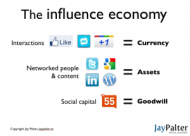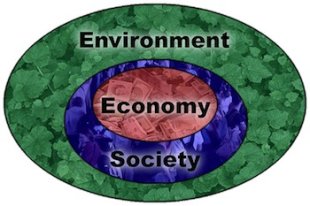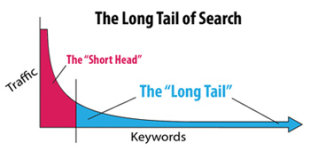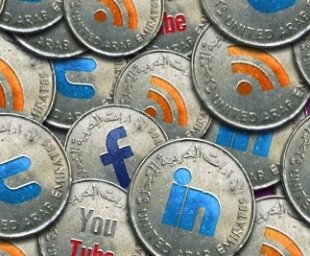
What I find helps most to improve understanding for business people is to talk about social networks in economic terms.
I’ve adopted the term influence economy to describe the system of social networks and activities and how they function to help us stay informed, make decisions and understand what is happening in the world around us.
And I use the term social capital to describe the goodwill that derives from effective social engagement, the accumulation of which I believe should be the goal of our social media activities.
As any wise social strategist will tell you, knowing why you’re engaging in social and what you’re trying to accomplish is key to getting results.
Perhaps you sell, influence or lead. Or maybe you advise, consult or create. If you do any of these things, you should be engaging in social networks in order to grow your social capital in the influence economy. Here’s why.
1. The influence economy is fundamental to human existence.
As I see it, there are at least three primal economies that matter most in human existence.

Second, there is the social economy – the interpersonal, social, political and cultural lives of human communities that underlies all financial value systems. That we trade at all and don’t live in perpetual war over resources is built on our ability to communicate and recognize mutual interests.
The influence economy, in a way, has always existed informally in human communities. Social networking technologies and tools have merely begun to formalize our influence within these networks.
And finally, there is the monetary or financial economy – the exchange of goods and services among individuals and business entities. In no way am I suggesting that the financial economy is any less fundamental to our day-to-day survival than the social economy. In fact, I think the two mutually support each other.
For most businesses, the primary objective is to increase sales revenue and profits as a strategy for accumulating wealth. My point here is that social networking is not something optional that you do if you happen to have the time. It is primal. It is the basis of human relationships on which financial exchange and the success of your business rests in the long run. Ignore the influence economy at your peril.
2. Though social capital is an intangible, it reflects on how well you’re known, liked and trusted.
Social capital can be most simply understood as the good reputation and influence of your business or personal brand. Like the concept of goodwill in business valuation, social capital is an intangible whose value is determined by others.
“A brand is no longer what we tell the consumer it is – it is what consumers tell each other it is.” ~ Scott Cook, Intuit
Social capital has many benefits in business. It can be used to attract referrals and strong word of mouth recommendations. It can attract partnerships and business opportunities that you may not even be seeking out.
More than just reputation, social capital is a reflection on your credibility and reliability within social networks, your ability to contribute to collective understanding and add value to relevant conversations, and a sense of goodwill and reciprocity that people feel toward you. Social capital often attracts people to you and your organization with an openness to doing business with you because they feel they already know, like and trust you.
Your social media activities should be focused on accumulating social capital, whether or not you have a way of monetizing it. Because you can’t have too much goodwill in business – and there’s always a way to put it to good use.
3. Your social networks are valuable, measurable assets.
Social networking technologies turns informal human social networks that often have intangible value into real assets with measurable value.
Your LinkedIn network might seem to you like it’s only a collection of your business contacts that you’ve accumulated over the years. But it’s more than that. Your unique network on LinkedIn or Twitter or any social networking site, with you at the centre, takes on a material value that doesn’t exist in the informal connections among the individuals themselves.
Let me give you an example. The fact that your connections on LinkedIn can see and interact with each other based on their relationship to you is a functionality that simply doesn’t exist in an informal network. And this is something that gives LinkedIn and other social networks real asset value.
When you go onto Twitter and build a follower list of several hundred or even thousands of people that are themselves subject matter experts and influencers within their networks, you are building an asset with real value in the influence economy.
4. Your networked content is also an asset that can accumulate value over time.
People are familiar with the use and value of content in the mass media age. By writing a column in a newspaper or magazine, you can demonstrate your subject matter knowledge and build your reputation. Or you find a publication whose content is attracting your market and you advertise alongside that content.
This value chain still applies in the social era, but the content vehicles are changing. Websites and blogs are replacing print publications and search, increasingly with the help of social signals, has become the dominant mode for finding information.
Here’s how networked content accumulates value in the social era.
An article is published on a blog site and the search engines index it. You share it in your social networks, then your followers, friends and connections reshare it and drive traffic to the article.

During this extended period of time, your article is continuing to attract clicks and traffic through keyword searches in the search engines. Over time, the article’s value to you is increasing because of this additional traffic it’s generating.
Now, if you’re in a business that sells a discrete product or service (let’s call it a “widget”), then you can actually quantify the value of a visitor to your site based on the rate at which you can convert a visitor to a buyer. If your business is not selling “widgets”, but instead something less material like advice, insight, or knowledge, then the value of a visitor gets more complicated to calculate.
But the fact remains: self-publishing high quality content and networking it in search databases and social sites gives that content asset value in the influence economy.
5. The currency of the influence economy are likes, follows, retweets, mentions, +1s, shares, comments, etc.
Winning the attention and goodwill of your audience is the prime objective in the influence economy.
When people read something you’ve shared or written, or when they like it, or comment on it, or better yet, share it with their network, they are paying attention to you.

This attention and influence can be used to increase traffic to your networked content and to your web properties. It can also be used to increase your profile and visibility within your own networks.
A new generation of influence measurement tools like Klout, PeerIndex, Kred, etc. count these actions precisely as if someone has paid you in the form of influence – and then use this data to render a score or a matrix of scores. Empire Avenue is an interesting social influence site in that they render your score as a stock price that can be traded among your network.
None of these scoring systems on their own can or should be seen as embodying something as nuanced as your influence within social networks.
However, in the aggregate, these influence scores and the activities they track are increasingly useful in identifying people with the greatest ability to accumulate social capital.
More Social articles from Business 2 Community:




